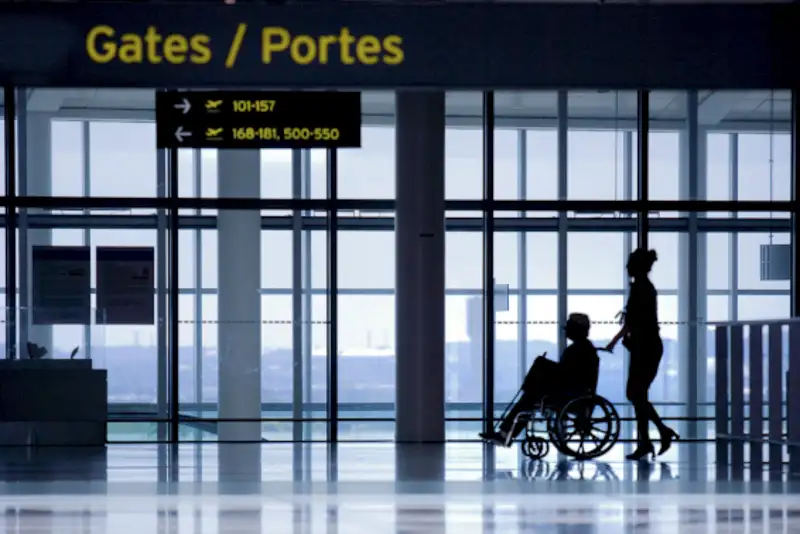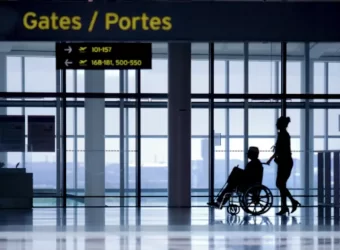Flying with a Wheelchair — Air Travel Tips and More
 Travel by its very nature requires a good amount of preparation, especially when it includes air travel. Factor a disability into that equation and the complexity increases. With that in mind, here are some helpful tips for flying with a wheelchair.
Travel by its very nature requires a good amount of preparation, especially when it includes air travel. Factor a disability into that equation and the complexity increases. With that in mind, here are some helpful tips for flying with a wheelchair.
Before You Go
- The first thing you should do if you are flying with a wheelchair is to learn the law so you know what to expect. The Air Carrier Access Act (ACAA) — not the Americans with Disabilities Act — is that law that covers access on all US carriers, and foreign carriers on flights to and from the US. You can find the ACAA at https://www.ecfr.gov/current/title-14/chapter-II/subchapter-D/part-382.
- Flying with a wheelchair in some parts of the world can come with some additional problems. If your trip involves domestic flights in Asia, Africa and the Caribbean, learn about the local access laws. Many domestic carriers in these regions have denied boarding to unaccompanied wheelchair-users. Choose your airline carefully.
- Request a seat with a flip-up armrest when you make your reservation, as it makes transfers easier.
- If you need a non-ticketed escort to accompany you to the gate, advise the airline of this when you make your reservation. Your escort will be asked for photo identification and given a security checkpoint pass.
- Even if you don’t routinely use a wheelchair at home, consider requesting an airport wheelchair when you book your reservation if you are a slow walker. Some airports are quite large, and the whole boarding process can involve a lot of walking and standing.
- Under the ACAA, airlines are required to carry wheelchairs, other mobility aids and assistive devices free of charge. This can include everything from oxygen concentrators and ventilators, to shower chairs and even catheter supplies. That said, remember to pack medical supplies in a clearly labeled box, and do not mix them with your personal items.
- If you are traveling with oxygen or a ventilator, contact the airline to find out about their specific rules and procedures. Some airlines require doctor’s forms, so plan ahead for this.
Important Websites and Phone Numbers
- The Department of Transportation (DOT) has several helpful brochures on accessible air travel at https://www.transportation.gov/individuals/aviation-consumer-protection/traveling-disability
- If you have any questions regarding security screening procedures, call the TSA Cares hotline at (855) 787-2227 at least 72 hours prior to your flight. They will be able to supply you with airport specific information regarding your inquiry.
- Download the TSA Notification Card (www.tsa.gov/sites/default/files/disability_notification_card_508.pdf), then fill it out with the specifics of your disability. Hand it to the TSA agent when you get to security. This is especially helpful if you have places on your body that are sensitive or painful to touch.
- Finally, it you are flying with a wheelchair and you have any questions about the ACAA, call the DOT Hotline at (800) 778-4838.
At the Airport
- When flying with a wheelchair, you can stay in your own wheelchair until you get to the gate, if you have non-spillable (gel) batteries. At that time you will be transferred to an aisle chair and boarded, and your wheelchair will be gate checked. If your mobility device does not have non-spillable batteries, you must transfer to an airport wheelchair at check-in, and surrender your wheelchair or scooter at that time.
- If your mobility device has lithium ion batteries, contact the specific airline for their rules and regulations. US airlines are allowed to carry mobility devices with lithium ion batteries, however they are not required to do so. Every airline that accepts these devices has their own procedures,
- If you use an airport wheelchair, don’t give it up once you get to the gate, because if there is a gate change you won’t have any way to get to the new gate. And sometimes it can be a very long walk.
- Always allow extra time to get through security. Carry your wheelchair repair tools in your checked bag. If you encounter any problems at the security checkpoint ask for the Passenger Support Specialist, as these employees have additional training in access issues.
- Remember, you are not required to perform any tasks at the security checkpoint that you are physically unable to do. If an TSA employee asks you to stand, walk, or even take off your shoes, just let them know that you are unable to do that.
- When flying with a wheelchair, let the gate agent know that you need to preboard the aircraft. This will give you extra time to transfer and stow your gear in a more private setting. And don’t wander off from the boarding area, as you could miss preboarding.
Protect Your Wheelchair
- Attach clear assembly and disassembly instructions (in Spanish and English) to your wheelchair or scooter. Photos and illustrations also help.
- Remove any loose or protruding parts from your wheelchair or scooter. Protect your joystick with some type of a hard covered object, such as a plastic cup secured with packing tape.
- Let a little bit of air out of your wheelchair tires. Carry on all gel cushions. Baggage compartments are not pressurized.
- Snap a digital photo of your wheelchair before you board. It’s a good way to document the condition of your assistive device in case of damage.
- Make sure you have adequate insurance. US airlines are only liable for the purchase price (not the replacement cost) of assistive devices on domestic flights. And on international flights the airline liability limit for damaged assistive devices is covered under the Warsaw Convention ($25.29/kilo) or the Montreal Convention ($1731 limit).
- Put an air tag on your wheelchair. It won’t prevent it from getting misrouted, but at least you will know where it’s at if it doesn’t show up at your gate.
On the Airplane
- On aircraft with more than 100 seats, there’s priority storage space aboard for one manual wheelchair. This space is available on a first-come basis, so it pays to get to the boarding area early, to get the first crack at the space.
- Make sure an on-board wheelchair is aboard the aircraft before takeoff. If you cannot walk, this is how you will be transported to the lavatory. On-board wheelchairs are required on all aircraft with accessible lavatories, but sometimes they are accidentally offloaded, so it always pays to check.
- Consider your toilet options when flying with a wheelchair, and plan ahead. Accessible airline lavatories are available on wide-body (two-aisle) jets. They have to be large enough to accommodate the on-board wheelchair, but in some cases there is not enough room for an attendant. Check out the aircraft diagrams at seatguru.com/ to find planes that have larger accessible restrooms.
If Things Go Wrong
- If you encounter any problems when flying with a wheelchair, contact the Complaints Resolution Official (CRO). The CRO is an airline employee that’s specifically trained about the ACAA. All US airlines are required to have a CRO on duty during airport operating hours. Foreign carriers are also required to have a CRO available at airports that serve flights that begin or end in the US.
- If your equipment is damaged or you experience a access related service failure, report it to the airline and request compensation. If your assistive device is not usable, be sure to request an appropriate loaner.
- And if you experience an access-related service failure, you can also file a ACAA complaint at secure.dot.gov/air-travel-complaint. This complaint will not result in compensation but it can help to make air travel more accessible in the long run.

